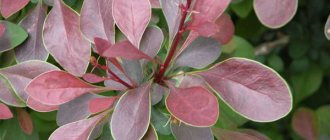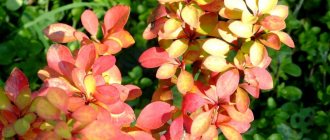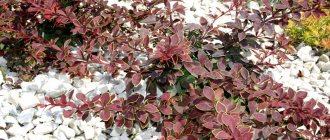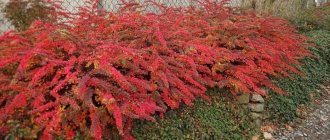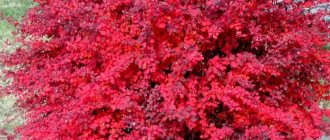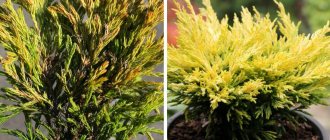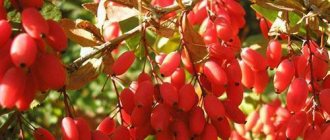Barberry Thunberg Rose Glow: reviews, photos, description of perennial
Ornamental perennial shrub Thunberga Rose Glow with pinkish foliage will be a bright accent in any garden.
. Description of the barberry variety Rose Glow, reviews from those who grow it, propagation rules, nuances of planting and care - all this will be discussed in the article.
The content of the article:
1. Barberry Rose Glow - description of an ornamental shrub 2. Useful qualities 3. General rules for planting barberry 4. Planting a seedling 5. Barberry Rose Glow in garden landscape design 6. Feeding barberry bushes 7. Caring for barberry 8. Propagation of barberry Rose Glow by cuttings and by dividing the bush 9. Protecting barberry from pests and diseases 10. Reviews of barberry Rose Glow
Description
The natural habitat of the ornamental deciduous shrub Thunberg barberry is the Far East. The plant is also found in North America and parts of Europe. In Russia, the bush has become widespread and is often used to improve gardening and park areas. Due to its frost resistance, it is possible to grow Darts Red Lady in the cold regions of our country. The botanical description of the crop variety is as follows.
- The wide crown of the bush has a rounded shape. In its size it can reach 1.5 meters.
- The height of an adult plant can range from 1 to 1.5 meters.
- The growth rate of the shrub is average, up to 10 centimeters per year.
- The trunk and shoots of barberry are covered with needle-like tufts.
- The arched branches of the plant are ribbed, young shrubs have a pale red color. The branches of adult barberry acquire a rich brown color.
- The buds on the bushes of this variety are egg-shaped and painted in a pale red hue.
- On the petioles of barberry there are small round leaves, they are colored crimson. In autumn the color of the leaves turns fiery red.
- The beginning of flowering occurs at the end of spring, in the second half of May. The inflorescences have a weak aroma, are painted pale yellow, and are covered with red stripes on top.
- Red fruits appear in autumn and cover the shoots of the bush until spring.
Barberry Rose Glow - description of an ornamental shrub
This type of barberry is tall. With proper care, Rose Glow grows up to one and a half meters in 10 years.
Every year the branches grow by 15 cm. The crown of the bush expands to 2 meters. Young stems and leaves of Rose Glow are pink. Gradually, the leaves become purple with rare strokes, spots and stripes of pink, red and bronze shades. Under the bright rays of the sun, the leaves look silvery.
Photo of Barberry Rose Glow
Rose Glow barberry begins to bloom in late spring.
Then each of its stems is densely covered with yellow flowers, the outer petals of a reddish hue. The leaves turn orange in autumn. Gradually they fall off, then the oblong fruits, up to 1 cm long, turn bright red on the bush.
Important!
It is not recommended to eat the fruits of the Rose Glow barberry; they and the bark of the plant are considered poisonous.
To the description of Rose Glow barberry, it should be added that long spines are clearly visible on the lignified gray shoots.
Brief overview of Rose Glow barberry - video
How to care for barberry Natasha
Despite the fact that barberry Natasha, like other representatives of the Thunberg variety, is quite unpretentious, it requires some care. These are the basic rules that absolutely all plants require: watering, fertilizing, pruning.
Watering
Watering is required mainly in hot, dry weather. To do this, use only warm water. Watering should be at the roots so that water does not fall on the leaves of the Natasha barberry. Young, newly planted plants are also watered until they take root. In rainy weather, watering is not required at all.
Important! You cannot overwater barberry; if moisture stagnates, the plant may die.
Top dressing
Fertilizing is applied once a year; nitrogenous fertilizers are recommended for this variety of barberry. If you plan to grow Natasha for harvesting berries, it is worth applying potassium-phosphorus fertilizers at the beginning of summer.
Trimming
This variety requires virtually no pruning. If everything goes well, you don’t have to pick up the pruning shears at all. Only damaged, dried out or improperly growing shoots are removed.
Important! This procedure is carried out in the spring
Barberry Thunberg Rose Glow: general rules for planting
Barberry prefers to grow in a sunny place, but protected from cold winds. In partial shade its foliage will be less decorative.
On a note!
To plant a Rose Glow bush, you need loamy, slightly fertile soil where plants have not yet grown. Barberry is undemanding to the soil; it has adapted to survive even in rocky soil.
The soil reaction should be neutral, with a slight deviation in any direction.
Useful article:
How to improve soil fertility in your garden
Groundwater should not come close to the soil so that moisture does not stagnate when snow melts and after a thunderstorm.
Drainage is definitely needed, although when planting, the Rose Glow barberry seedling must be watered abundantly.
Photo of barberry seedling Rose Glow
Thunberg barberry can be planted in spring and autumn, but only when the bushes are at rest. Otherwise, Rose Glow will take a long time to take root or die. But seedlings in a container can be planted in the summer.
Reproduction methods
The most effective method of propagation is layering. The plant inherits 100% of the characteristics of the variety. A young one-year-old shoot is selected as a layering. Using staples they are pulled to the soil. The end of the shoot is placed vertically. At the end of the summer season, a root system forms under the ground.
The division of the bush is carried out in the spring. Divide the plant into three parts. Immediately transplanted to a new place.
To make cuttings from a young shoot, you need to cut off the cuttings, leaving 5-6 buds. Place the bottom three in the ground and leave the rest above the surface. Water the soil generously. Place a glass jar over the cutting. After three weeks, young shoots will sprout and the root system will form.
Important! Rose Glow is an ornamental plant that can grow on rocky soil.
When propagated by seed, ripe berries are selected. The seeds are separated from the pulp and then dried. In the fall, they are deepened into the ground by 1 cm. In the spring, the seedlings are thinned out so that there is at least 3 cm between the seedlings. They are transplanted to a permanent place after two seasons.
A seedling takes root best in a container
Planting barberry seedling Rose Glow
When purchasing a barberry seedling in a container with its roots covered, you should dip it in water before planting if the soil in the pot is dry.
Stages of planting barberry:
- For other seedlings, dried and damaged roots should be removed before planting.
- Place in a container with water for 3 hours, it is advisable to add a root formation stimulator.
- A bucket of water is poured into the hole, a Rose Glow barberry seedling is placed in the middle and covered with prepared soil.
- The root collar should be left at ground level or slightly higher.
The soil is patted with hands and watered again. After planting the barberry, the tree trunk circle should be mulched with sawdust or peat. This will maintain soil moisture. The shrub will take root faster.
The distance between the bushes depends on the place where they are planted:
- to plant Rose Glow barberry in a group, the distance between the bushes should be left at least one and a half meters;
- when planting along the perimeter of the site as a hedge, the distance is reduced to half a meter.
DECORATIVE PLANT!
Park rose Louis Odier
The roots of the bush are located at the top, so a hole for young bushes is suitable with a depth of 25 cm. For other seedlings, the hole needs to be deepened to half a meter.
When planting a Rose Glow barberry hedge, dig a trench 40 cm deep and wide.
Instead of the excavated soil, the hole is filled with sand, humus and garden soil, taken equally, with the addition of a glass of ash and 100 g of phosphate fertilizer.
Conditions for planting in the ground
Often, Thunberg Admiration barberry is sold as grown seedlings in individual containers with a root ball of earth. When buying a plant from hand, there may be specimens dug out from open ground with a bare root system. Shrubs are planted on the site in the spring - when the ground has already dried out or in the fall, before the onset of rains and frosts. Proper planting is necessary as follows:
- Dig a hole up to 50 cm deep and about 40 cm wide so that the root system fits completely.
- Put fertilizer - humus - at the bottom.
- Place the seedling in the center and fix it in a vertical position without the slightest tilt to the sides.
- Cover the root system with soil and compact it a little for stability (it is recommended not to fill the hole completely with soil to form a hole for watering).
- Water the bush with 1 bucket of water.
- It is advisable to immediately mulch the hole near the trunk to better retain moisture.
After planting, it is necessary to periodically loosen the soil for better plant growth.
Preparing seedlings and planting area
Seedlings of the Admiration variety with a closed root system are planted at any time, from spring to autumn. Plants grown in containers have healthy, well-developed root systems and therefore thrive better.
It is advisable to plant Admiration barberry seedlings with bare roots immediately after purchase. The purchase of such plants should occur before the sap flow begins (before buds open) or after it ends (after leaf fall).
Advice! If you need to delay the planting procedure, you can temporarily bury the seedlings in the shade or wrap the roots with a damp cloth. You can also place the roots in a plastic bag.
Barberry Admiration prefers well-drained, light soils with neutral acidity. Tolerates some soil salinity. The Admiration variety develops better if the soil in which it is planted consists of sand, humus and turf in a 1:1:2 ratio.
In acidic soil it grows slowly and does not set fruit. Therefore, acidic soil must be prepared for planting seedlings by liming. This can be done using slaked lime at the rate of 350 g per plant or wood ash at 250 g per bush.
Optimal timing
Rooting into the ground is recommended in the spring. It is worth choosing the months when the buds have not yet swelled, or planting barberries in the fall. As for the timing of planting seedlings with a closed root system, there are no strict restrictions for Thunberg barberry in this regard, with the exception of the summer months.
Barberry Rose Glow in garden landscape design
Barberry Thunberg Rose Glow will look beautiful next to other less ornamental shrubs
, which will shade its brightness. For example, next to spirea - with its white flowers, pink barberry leaves will look very elegant.
Photo of barberry Thunberg Rose Glow with other ornamental shrubs
It makes sense to plant Rose Glow next to Hydrangea paniculata.
. Its white and then pink flowers form a beautiful color ensemble with the bright colors of barberry.
Can be planted in front of Konica spruce, thujas and junipers
.
Barberry tolerates pruning well, so it can be planted as a hedge
.
How to plant and grow?
Before you start planting the Rose Glow variety, you need to choose a suitable location. The shrub prefers sunny areas protected from the wind with light natural shading. It is advisable to use soil of medium acidity with a pH value of 7.5. If acidified soils predominate on the site, then liming should be carried out every 3 years. To do this, add 300-400 g of slaked lime under each root.
Alkaline soils, on the contrary, are slightly acidified with peat. Humus and turf soil are added to depleted soils, and clay soils are diluted with sifted river sand. Due to its unpretentiousness, the variety is able to grow even on rocky soils, but the best option for it would be loamy or sandy loam compositions with a moderate content of organic matter.
Once the location has been determined, you can begin selecting seedlings. Bushes for planting can be sold with both open and closed root systems. Plants with closed roots do not need preparation and can be planted in a new location at any convenient time. Bushes with exposed roots are carefully inspected, dry and damaged shoots are removed, and soaked in the Kornevin solution for 3 hours.
Then they begin to dig holes, taking into account that the root system of barberry grows in breadth and not in depth. In this regard, for small seedlings, holes with a depth of 25-30 cm are sufficient, for adult bushes - 50 cm. The width of the hole is determined independently, taking into account the volume of the rhizome. The distance between adjacent bushes is calculated based on the purpose of planting.
For example, when forming a hedge it should be 50 cm, and when designing a landscape composition - 1.5 m.
As for the timing of planting “Rose Glow”, the variety can be planted both in spring and autumn, as long as the seedling remains dormant. This is due to the fact that the fragile root system is unable to fully nourish the awakened bush. However, this requirement is valid for plants with an open root system; shoots with closed roots are able to take root throughout the summer.
The barberry planting algorithm is as follows:
- At the bottom of the pit, drainage is laid from crushed stone, expanded clay or broken brick and a layer of sand no more than 5 cm thick is poured;
- pour the prepared nutrient substrate on top, consisting of garden soil, sand and humus, taken in equal parts, and add a glass of wood ash and 100 g of phosphorus-containing preparations to each hole;
- pour a bucket of water into the hole, place a seedling in it and carefully straighten the roots;
- the roots are covered with planting soil mixture, compacted well and watered again;
- after the moistened soil has settled, the soil is added, making sure that the root collar is flush with the ground;
- the surrounding area must be mulched with straw, sawdust or peat.
Caring for the Rose Glow variety is very simple and includes weeding, watering, fertilizing, pruning and preparing for winter.
It is recommended to water only young bushes, but this should be done no more than once a week. Adult barberry does not need regular watering and is content with precipitation. The exception is a prolonged drought, during which the bush is watered with warm water, and this is done in the evening, after sunset.
Rose Glow is fed three times per season, starting from the second year after planting. Any nitrogen-containing preparation, for example, a urea solution, is used as a spring fertilizer. The second feeding is carried out on the eve of flowering, using any complex mineral fertilizers for flowering plants. The third feeding is carried out in the autumn, after the plant has flowered. To do this, add 15 g of superphosphate and 10 g of potassium sulfate to the tree trunk circle, dig up the soil well and water it.
Organic fertilizers are applied once every 3 years, using an infusion of mullein or bird droppings. After adding organic matter, the bushes are well watered with warm water.
Feeding barberry bushes
Barberry Rose Glow needs to be fed only from the age of 2 years.
in spring
Stir a spoonful of urea in a bucket of water and pour it under one adult plant. For younger bushes, fertilizing will have to be reduced by 2-3 times.
It is useful to feed barberry before flowering
1 spoon of mineral fertilizers, mixed with the soil and scattered under the bush. After feeding, the bushes need to be watered.
In September
10 g of potassium sulfate and 15 g of superphosphate are poured under each plant and deepened into the soil.
Organics are added after 2 years. Then water it abundantly.
Planting and caring for white currants
- Planting: in September or early October.
- Lighting: bright sunlight.
- Soil: fertile, moisture-absorbing, slightly alkaline or neutral, in an area where groundwater lies below 60 cm.
- Watering: sufficient, especially in early June, during the formation of ovaries, and from the second half of June to the fourth ten days of July, during the filling of berries. Water consumption when watering per m² is 20-30 l: you need to wet the soil to a depth of 30-40 cm.
- Fertilizing: in the spring, nitrogen fertilizer (urea) is added to the soil, and in June, organic matter is applied - a solution of mullein or bird droppings, but complex mineral fertilizers in liquid form can also be used. If necessary, in the summer, fertilize the leaves with microfertilizers, and by mid-autumn, 10-15 kg of humus and full mineral fertilizer are applied to each plant.
- Pruning: in the spring, before the buds swell, sanitary and formative pruning is carried out, in the fall - sanitary pruning.
- Reproduction: layering and cuttings.
- Pests: various types of aphids, moths, mites and currant glass beetles.
- Diseases: anthracnose, powdery mildew, goblet and columnar rust, septoria, cercospora, mosaic and terry.
Caring for Barberry Thunberg Rose Glow
Watering.
Young seedlings need to be watered weekly. The rest need to be watered only in hot weather with heated water.
Trimming.
Barberry is trimmed carefully in the spring with scissors, being careful of sharp thorns. When cutting, remove excess stems.
Trimming border barberry bushes
carried out in early summer and August using a long ruler so that the bush takes the shape of a ball.
Photo of barberry bushes in the shape of a ball
At the hedge, the stems are shortened by half for denser branching.
Features and care of Thunberg barberry - video
Preparing for winter.
In the fall, the Rose Glow barberry bush should be wrapped in non-woven material and mulched with a bucket of humus.
Caring for white currants in summer
In the summer, it is very important to keep the soil in the area where currants grow in a moist, loose state. Do not forget to remove emerging weeds in a timely manner
In June, you need to apply organic fertilizer to the currants, but if you do not have organic matter, replace it with mineral fertilizers. It is advisable to combine fertilizing with watering.
Carefully monitor the condition of the bushes so as not to miss signs of disease or pest damage. As soon as you notice the presence of insects or symptoms of disease, treat the white currants with an appropriate fungicide or insecticide.
In July and August, white currants begin to ripen. Collect it in whole clusters in a hard container in which the berries do not wrinkle. After harvesting, currants require mandatory watering, and after that, loosening the soil on the site.
Propagation of barberry Rose Glow by cuttings and dividing the bush
Cuttings
Cuttings are taken from the middle of young plants
approximately 10 cm long, 5 mm thick. The cuttings are cut obliquely.
The lower leaves are torn off, and the upper ones are cut in half.
Rose Glow barberry cuttings are dipped in a growth stimulator and buried 1 cm in loose soil containing sand and peat and preferably vermiculite.
Sprinkle a layer of sand up to 4 cm on top. The soil must be watered and sprayed daily. After 1-2 years, the seedlings are transplanted into the garden.
Dividing the bush
Barberry Rose Glow can be propagated by dividing the bush
, the best time is spring, before the buds have opened. For this method, you can use plants that have reached 3 years old.
Photo of barberry propagation by dividing the bush
The plant is dug up and divided into sections with pruners, so that the roots and stems are preserved on each part. The cut area is powdered with charcoal.
Reproduction
It makes no sense to propagate varietal barberries, including Rose Glow, by seeds - the seedlings will not replicate their parents. The only way out is vegetative propagation: by dividing the bush and cuttings. The latter method is especially good if you need a large number of barberry plants to create a hedge.
Rules for cuttings
- the best survival rate is for green barberry cuttings cut in June;
- for cuttings, choose this year's growth, the middle part of the shoot with 4 leaves and one internode, about 10 cm long and half a centimeter thick;
- The bottom is cut obliquely, the top is cut horizontally;
- Having removed the lower leaves and cut off the top 2 leaves in half, the barberry cutting is dipped with the lower part in root formation stimulator powder;
- It is better to root cuttings in a mini-greenhouse, the soil is light, a mixture of sand and peat with the addition of vermicult;
- there should be a layer of sand on top, 4 cm thick, and planting is carried out in it with a slope to the south and a depth of 1 cm;
- feeding area for each cutting – 5x7 cm;
- Soil humidity is constant and air humidity is 85%, which is achieved by frequent spraying.
Protecting barberry from pests and diseases
Too much rainy weather is extremely unfavorable for Rose Glow barberry, as it often suffers from fungal diseases.
Powdery mildew. A white coating appears on the foliage. Affected leaves will have to be torn off and sprinkled with colloidal sulfur. If it rains constantly, then to prevent it it is useful to treat the plants with a copper-containing fungicide.
Rust.
Orange spots form on the leaves. You need to fight them the same way.
Spotting.
Spots form on the foliage and dry out quickly. It is necessary to spray with a solution of copper oxychloride.
Dry branches and necrosis of the bark.
With such diseases, it is necessary to remove the damaged areas; up to 15 cm of undamaged tissue is captured. The bush must be sprayed with a solution of copper sulfate.
Bacteriosis.
Dark spots form on the bush. Damaged parts of the fabric should be cut out.
What to feed and what diseases of barberry there are - video
Diseases and pests
The immunity of Thunberg barberry "Aurea" is considered quite strong, plants rarely get sick, especially with fungal diseases, and pest attacks are an infrequent occurrence. At the same time, it is necessary to monitor the condition of the plant, since early detection of the disease gives a greater chance of quick and problem-free treatment. You should be wary of the following problems:
- fungal infection powdery mildew;
- fungal spotting, which can have different variations;
- dangerous aphids, which can dry out the bush;
- rust on the foliage spoils its decorative appearance, the leaves dry out and fall off;
- the flower moth eats the fruits;
- The leaves are gnawed by the barberry sawfly.
Powdery mildew is most often found in different types of barberry; this disease manifests itself as a white coating on the leaves. It is necessary to take immediate action, otherwise the entire bush will be infected. The affected areas are cut off and the plant is sprayed with special products. Preventive measures protect the plant not only from powdery mildew, but also other types of fungi.
Barberry Rose Glow: reviews from those who grow
Due to the attractive color of the Thunberg barberry Rose Glow, it is a frequent guest in the gardens of summer residents; some reviews are presented below.
Irina, Moscow region:
“The Thunberg barberry variety Rose Glow has been growing for me for several years now; in the landscape design of the garden it complements the beauty of bush roses. A very beautiful and decorative variety of barberry. Among the disadvantages, it is worth noting poor resistance to powdery mildew.”
Choosing good flower seeds!
How to choose good flower seeds
Olga, Moscow region:
“Unfortunately, this Thunberg barberry is constantly freezing. But his bushes are really beautiful and bright, I advise you to try planting them, I really like his appearance. If the frost resistance of the Rose Glow variety were higher, then it would not have a price.”
The barberry variety Goose Glow is often grown by amateurs in the garden; it is capable of decorating any space with its bright decorative nature.
Beneficial features
In folk medicine, all parts of barberry are used. They help strengthen the immune system, relieve inflammation in the gastrointestinal tract, and lose weight due to their diuretic and laxative properties. But, before starting treatment with traditional methods, you should definitely consult a doctor.
Barberry Thunberg variety Rose Glow is a plant with beautiful pink-burgundy leaves. The bushes are easy to care for; even inexperienced gardeners can grow them. Plants overwinter well without shelter and can withstand slight drought without losing their decorative properties.
Using barberry in landscape design
The shapes of barberry are quite diverse, as are the colors of plants. Flowering is considered a pleasant decoration in any garden. Experienced gardeners often use barberry shrub because of its colorful description . The decorative qualities and aesthetics of flowering throughout the season are a motivating factor for planting such a plant on the site.
Before choosing a place for planting, you need to take into account other plants that will live with the barberry on the site. For example, cherry and walnut allow a chemical component into the soil that is harmful and prevents barberry from developing on the site. For this reason, the plant will begin to slowly die and will not be able to get along with these blooms.
What varieties of Thunberg barberry are there?
The Thunberg Admiration barberry is most often used in household goods. In addition to it, there are 9 more popular varieties.
Barberry Thunberg Admiration
Barberry Admiration is a miniature variety of this shrub - it grows no more than half a meter in height, forming a dense spherical crown. In summer, its leaves are yellow and orange, and by autumn they turn scarlet, with a yellow edging. The bush blooms in May, and in September it is strewn with red berries.
Barberry Thunberg Coronita (Coronita)
The bush of this variety grows quickly and a few years after planting reaches one and a half meters in height and a meter in width. However, active growth stops here, and even with the most successful agricultural technology, Koronit will not become a giant. The leaves on young branches of the bush are bright red, and on the shoots of previous years they are dark purple. The characteristic border is preserved in both cases.
The name barberry has Arabic roots and means “like a sea shell.” This epithet was awarded to the petals of the barberry flower, and then to the bush itself.
Barberry Thunberg Harlequin
The unusual variegated foliage of Harlequin attracts the eye. The height of an adult bush is about one and a half meters, the width reaches 2 m, so it needs to be given a lot of space. The bush grows quickly, giving a growth of up to 15 cm per year. However, young seedlings of the Harlequin variety are afraid of frost, and in the first couple of years it is better to cover them for the winter.
Barberry Thunberg Rose Glow
The Rose Glow variety bush is a real “two in one” in the garden plot. The bark and leaves of young shoots are colored variegated pink, while adult branches and leaves on them are purple-violet, almost bluish. On a large plant (Rose Glow bushes reach 1.5 m in height) it looks like a bright bouquet wrapped in a restrained tone.
Barberry Thunberg Golden Rocket
Growing the bright golden-green Golden Rocket to its maximum height is not easy - its shoots often break under the weight of snow and freeze slightly. Usually the bush is formed up to 70 cm in height, and the crown is tied or wrapped in a net for the winter.
Despite the decorative value of barberry, in a number of US states and New Zealand this plant is prohibited from growing and selling. The official reason is that barberry is an invasive plant, and tends to "outlive" others by taking its place.
Barberry Thunberg Orange Rocket
Narrow, upright Orange Rocket bushes look great in group plantings. The bush grows slowly and only in height - it will reach 40 cm in width and stop there. But the foliage acquires a rich orange color in the spring, turning red only in the fall.
Barberry Thunberg Aurea (Aurea)
The slow-growing bush of the Aurea variety is characterized not only by yellow or slightly greenish foliage, but also by the horizontal formation of the crown. It grows up to 1 m in width, but in ten years it will hardly reach 80 cm in height. The color of the leaves is best seen in sunny areas. This barberry is not afraid of frost and is indifferent to the soil, but it does not like strong winds.
Barberry Thunberg Cabernet
Another horizontal bush of unusual color can become the center of attention, because it has foliage in fiery shades all season long. In spring it is raspberry, in summer it is wine-colored, and by autumn it turns red-orange. True, the crown of Cabernet will have to undergo preventive pruning every year, otherwise it can take on the most bizarre shapes.
Ten years ago, the Italians found a way to extract a substance from barberry that has an effect similar to the famous Viagra.
Barberry Thunberg Maria (Maria)
Golden in spring and red in autumn, barberry variety Maria is quite whimsical - it requires pruning twice a year, is afraid of drafts and grows very slowly. However, if you decide to plant it and give the bush time, then in ten years it will become a lush, bright ball with a meter in diameter.
Barberry Thunberg Red Carpet
Barberry Red Carpet is a real fireworks of colors. There is a whole palette of colors here at once: from delicate spring greens to autumn gold and scarlet berry shades. Spreading curved branches take up a lot of space and are strewn with thorns, so it is better to plant Red Carpet away from paths. The bush is frost-resistant, but does not tolerate waterlogging and prefers alkaline soils.
Of course, it is difficult to single out the most beautiful varieties among barberries, because each of them is good in its own way. If you also love these bright, attractive shrubs, share with us photographs and names of your “favorites”.
Festive fireworks from my garden. Meet Thunberg's barberry “Rose Glow”
I was a little sad today. The rains are piercingly cold, and only occasionally the rays of the summer sun break through the gloomy clouds hanging over the forest. Even the fiery arrows of lightning do not want to add summer colors to the gray July. While looking through photos on my phone, I unexpectedly discovered a holiday bush; a summer holiday, a spring holiday, an autumn holiday, a winter holiday, a holiday for birds, a holiday for bumblebees and a holiday for us. It, like fireworks, explodes above the ground with a fountain of multi-colored leaves. I present a small photo selection depicting barberry. When I took photographs, I didn’t even think about the fact that today these pictures would lift my spirits. I am already smiling and sincerely hope that I can give you a good mood too.
The pink fountain emits light - The barberry is dressed in a festive outfit.
Pink fountain...even at night
A young shoot Its leaf - an artist, like a living cloud, dissolves unusual smoke in the greenery: diluting pink and white colors, exposes its cheeks to the kiss of the rain.
Leaf blade with a marble pattern in pink and white tones In drops of rain An unusually beautiful bush after the rain
The bumblebee playfully hides in a golden flower, intoxicated by the smell early at dawn. He collects pollen and he drinks nectar, flying buzzing from flower to flower.
Shemale butt)))
Here the branch is dressed in beads in silence, The berries that ripen in September are glowing with glitter.
Berries in July
This handsome man lives with me, but let the sadness go away or wait.
A very elegant deciduous shrub. Is not it? It is beautiful at any time of the year. In spring, when the first greenery blooms, its curved branches are clothed in green-cherry leaves.
in spring
...he's already handsome
Replete with white and pink blurry spots, like splashes of milk
The sun is reflected in it
The fruits ripen in September.
The shrub has thorns - these are modified leaves, about 1 centimeter long.
Thorn
Give yourself a festive mood by planting Thunberg's barberry "Rose Glow" in your dacha.
With respect and wishes for a good day, your Tatyana.
